by Alison Hugill // Oct. 6, 2023
In a recent episode of The Art Angle podcast about the exhibition ‘It’s Pablo-matic’—a takedown of Pablo Picasso at the Brooklyn Museum this spring, curated by comedian Hannah Gadsby—critic Ben Davis argued that a moral judgment about the artist as a person had been unfairly collapsed with an aesthetic judgment about his work, essentially aiming to retroactively “cancel” Picasso and his artistic oeuvre in no uncertain terms. “It’s not just apologists for Picasso’s misogyny that have a relationship to these artworks,” he explains. Speaking at a time when women’s and trans rights in the US have been tangibly and brutally rolled back, Davis recognizes the very real importance of exhibitions centering feminist art historical positions. And, for that reason, his call for nuance is not always well-received: “I’ve heard people make the argument to me that nuance is a code word for patriarchy, in the last five years…[The idea] that we’re going to concede nuance to the patriarchy is upsetting to me and potentially locks us into these ever-more fractious debates that lead me to some degree of despair.”
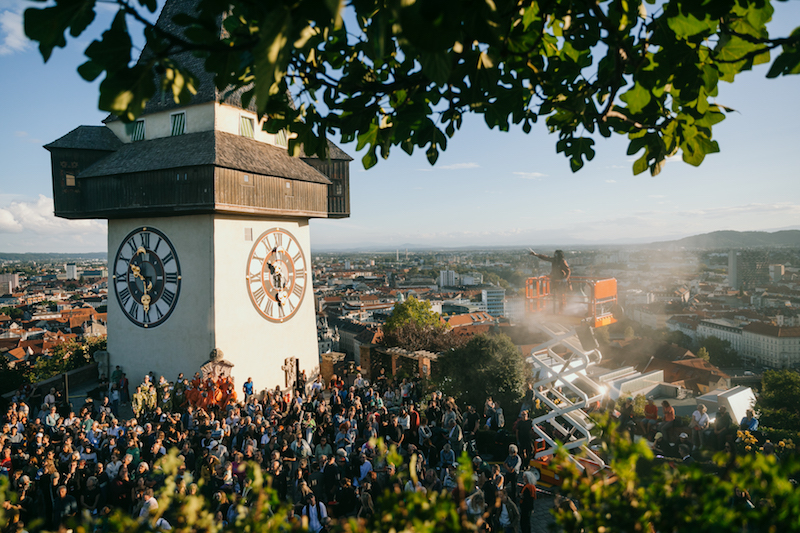
Lulu Obermayer: ‘Agoraphobia,’ 2023, performance // Photo: steirischer herbst / Johanna Lamprecht
It’s nuance, the “gray zone” antidote to good vs. evil morality, that’s at the conceptual heart of this year’s Steirischer Herbst festival in Graz, aptly titled ‘Humans and Demons.’ Attempting to fight off the discourse that would have us narrow our understanding of one another, the far-reaching program tackles the polycrisis of wars, pandemics, artificial intelligence and climate collapse using storytelling as a device, aiming to add a degree of subtlety to these polarizing topics. Each of the four main exhibitions centers around a figure, real or fictional, who embodies the dilemmas at the heart of the works on view.
The festival consists of these four shows, scattered across the city, as well as a robust program of performances throughout its three-week run. As in past iterations—such as last year’s ‘A War in the Distance’—artistic director Ekaterina Degot, alongside her team of curators, has put renewed emphasis on the war in Ukraine and its resonance with recent and historical wars in Europe. As a Russian national living in Austria, it’s important to both distance herself from the harmful decisions of Russian political leaders, but also to problematize the blanket demonization of Russians that seems culturally rampant at the moment. Thus, a strong stance against the war has been at play in the last few festivals, and this year it has taken a new tone. A tone that begs several questions: How to foreground nuance without collapsing into relativism? What can be gained from “humanizing” certain historical figures, usually cast as evil?
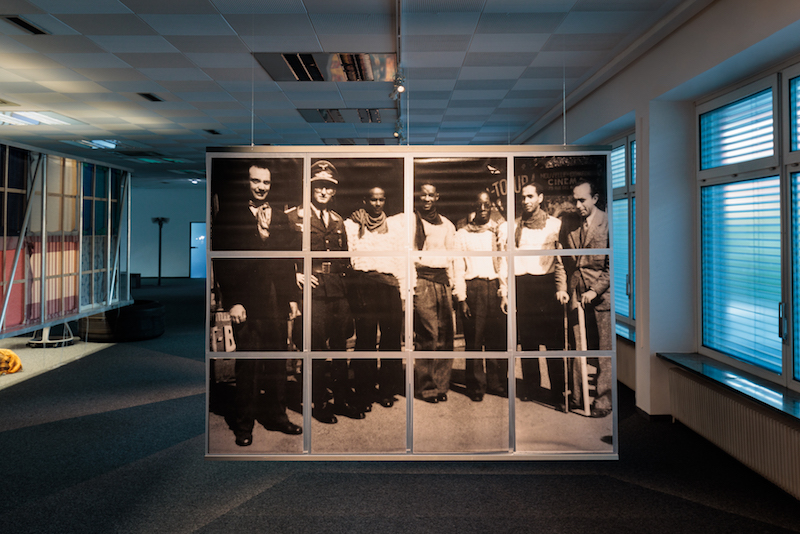
‘Dr. Jazzʼs Archive,’ curatorial intervention, ‘Demon Radio’ // Photo: steirischer herbst / kunst-dokumentation.com
Before we entered the exhibition ‘Demon Radio,’ located in a defunct call center in Mariagrün, co-curator David Riff offered an introduction to the figure that would define this show: Dietrich Schulz-Köhn, aka Dr. Jazz. Referring to him as a “good Nazi” and “less racist” than the rest, he elucidated the Luftwaffe officer’s profound interest in and support for jazz musicians throughout the Second World War, and beyond, as he continued to write about and host a radio program after the war, under the pseudonym Dr. Jazz. He is credited with helping jazz music and musicians to survive the Nazi regime, famously aiding Django Reinhardt to escape to safety in Paris. The fact that Schulz-Köhn came out the other side of that war—still a devout National Socialist, as we are informed—and maintained a public life as a jazz collector and radio host, might seem mind-boggling by today’s standards. But here, he’s used as an example of the complicated gray zone between moral guilt and pure innocence that often defines characters on both sides of a war.
Inside the exhibition, we find Schulz-Köhn’s collection of jazz records on display, meant to stand as proof of his defiance against the politics of his time. While I’m skeptical of this reading (again: he remained a devout Nazi postwar), I’m sympathetic to the argument as a whole, which is much better elucidated in the other works by participating artists, presented in the ‘Demon Radio’ show. Filmmaker Dani Gal shows his newest film ‘Dark Continent’ (2023), which deals with racial phobias resulting from the colonial imaginary, and their transmission through music. The film centers the figure of a young, white French woman who suffers from a nervous disorder triggered by the sound of African drums. A case study taken from Frantz Fanon’s influential book ‘Black Skin, White Masks,’ the story unravels in the film through a dramatization of the psychiatrist Fanon, listening to recordings of the young woman describing her psychosis to a priest or other Catholic religious figure inside a psychiatric hospital. In line with the curatorial purview, the piece highlights the ways in which colonialism sought to demonize certain cultural and artistic forms, in order to quash their relationship to grassroots forms of dissent or rebellion.
In another part of the exhibition, Ukrainian artist Anton Kats presents the sound installation ‘The Cemetery of Melodies Alive’ (2023), consisting of several rapidly rotating, institutional gray air raid sirens. The work, commissioned for the festival, plays a poetic narrative, drawing on memories from Kats’ childhood in Kherson, in a neighborhood recently flooded after the explosion of the Kakhovka Dam, which was blown up by Russian troops in June of this year. Weaving historical and semi-fictional accounts, the piece also warns of the imminent destruction of Europe’s largest nuclear power plant in Zaporizhia. Rooting visitors in one very real contemporary war “next door,” the piece uses poetics to add layers to a narrative that seems, right now, perhaps too raw and visceral to subject to the curatorial call for nuance.
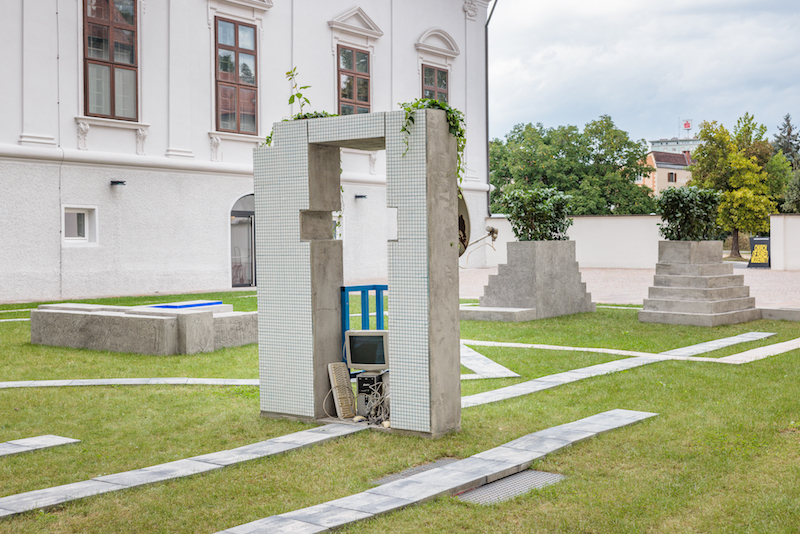
Maria Loboda: ‘What’s Best Is Hidden, Obvious, and Correct,’ 2023, installation view, ‘Church of Ruined Modernity,’ Minoritenkloster and Minoritenzentrum Graz // Photo: steirischer herbst / kunst-dokumentation.com, courtesy of the artist
In the center of Graz, next to the Mur river, the festival has occupied part of a still-active cloister, for the exhibition titled ‘Church of Ruined Modernity.’ In this space, the character of abstract painter and graphic artist Mira Schendel is foregrounded. Born in Switzerland to a Catholic family of Jewish origins, she managed to escape Nazism (via a passport acquisition in Graz) and eventually relocate to Brazil. Later, after the monastery in Graz started to be used as a regular exhibition venue in the 1960s, she had a show of her work here. The exhibition draws from her story, to consider the ruins of modernity in Europe postwar. Two of the strongest pieces in this show tackle the topic from an architectural perspective. Maria Loboda’s sculptural installation in the courtyard of the monastery plays on the duality in modernist architecture, between its representation of power, on the one hand, and its use as a tool of subversion, on the other. On one wall of another courtyard, Berlin-based choreographer Meg Stuart shows two video works, ‘Circuit Bending’ (2023) and ‘Shelf Life’ (2023), in which she and her collaborators physically trace the concrete architecture of the soon-to-be demolished Vorklinik in Graz, a pillar of modernist architecture in the city. As Stuart describes it: “Like the modernist project, the attempt to fit their bodies into the architecture of the Vorklinik is slated to fail.”
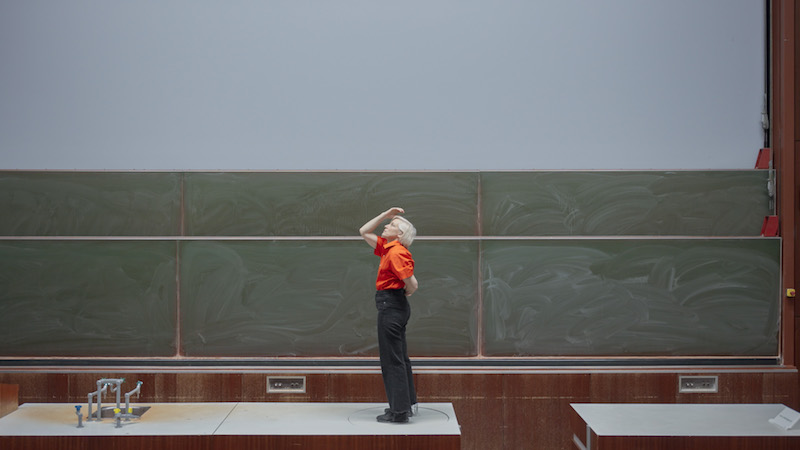
Meg Stuart: ‘Shelf Life,’ 2023, video still // Courtesy of the artist
In the rooftop of the monastery, a construction site in itself, the pièce-de-résistance of the festival is projected on a small screen under the bare-bones wooden rafters. Dana Kavelina began working on ‘The Lemberg Machine’ (2023) in 2019, before the war broke out in Ukraine. Describing it in her artist talk as “cursed,” the production of the film (partially animated in stop motion) was subject to many setbacks in its journey to completion. Beginning with a strange sci-fi scene, in which a masked figure looks into a peephole that grants access to the past (from what is known as the “Laboratory of History”), the film is a rich and deeply moving account of the 1941 pogroms against the Jewish community in Lviv, in western Ukraine. Including voice-over and songs in Yiddish, the film manages to encompass—powerfully, but also with a soft and careful tone—not only this historical atrocity, but also its resonance throughout the country’s history, under communism and now in a state of war.
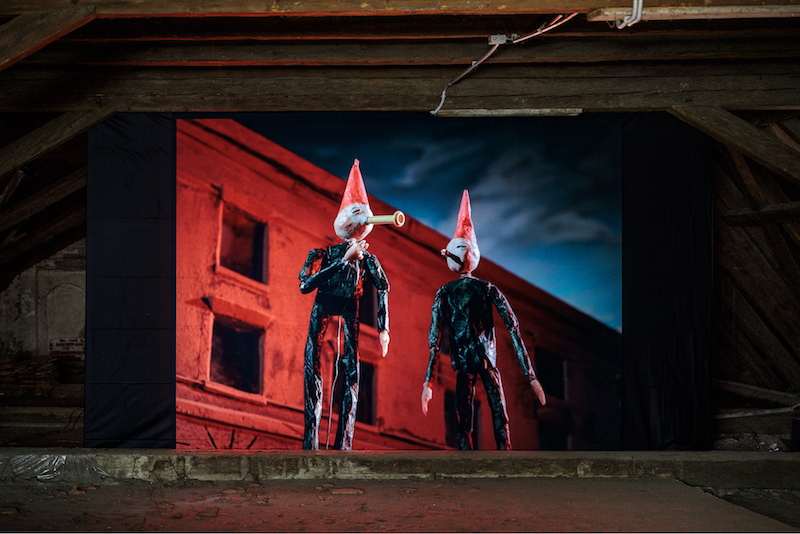
Dana Kavelina: ‘The Lemberg Machine,’ 2023, video, installation view, ‘Church of Ruined Modernity,’ Minoritenkloster and Minoritenzentrum Graz // Photo: steirischer herbst / kunst-dokumentation.com, courtesy of the artist
The festival continues to weave local, historical demons with present-day instances of war across its two other venues, in the exhibitions ‘Villa Perpetuum Mobile’ at Forum Stadtpark and ‘Submarine Frieda’ in a disused supermarket in the Gries neighbourhood of Graz. While the task set up by the curatorial team behind ‘Humans and Demons’ is not an easy one, it is certainly one that we can all learn from: To recognize and make room for the flawed and resilient nature of humanity. While we might not agree with the application of nuance in every circumstance, potentially leading us down the slippery slope to rampant “Devil’s advocacy,” its relevance as an epistemological device does seem ever-more urgent in our increasingly partisan social reality. As Ben Davis noted in the aforementioned podcast, there has to be a way to hold together nuance and criticism simultaneously, a kind of cultural restorative justice. With this in mind, visitors to this year’s Steirischer Herbst are forewarned: “Stories are never told to relativize reality nor to render its problems fluid and ambiguous…Audiences might be asked to suspend their disbelief, but they are never invited to suspend their judgment.”
Festival Info
Steirischer Herbst
Festival: ‘Humans and Demons’
Exhibition: Sept. 21–Oct. 15, 2023
steirischerherbst.at
Multiple Venues, Graz, Austria




















